2007 ISUZU KB P190 headlights
[x] Cancel search: headlightsPage 4424 of 6020
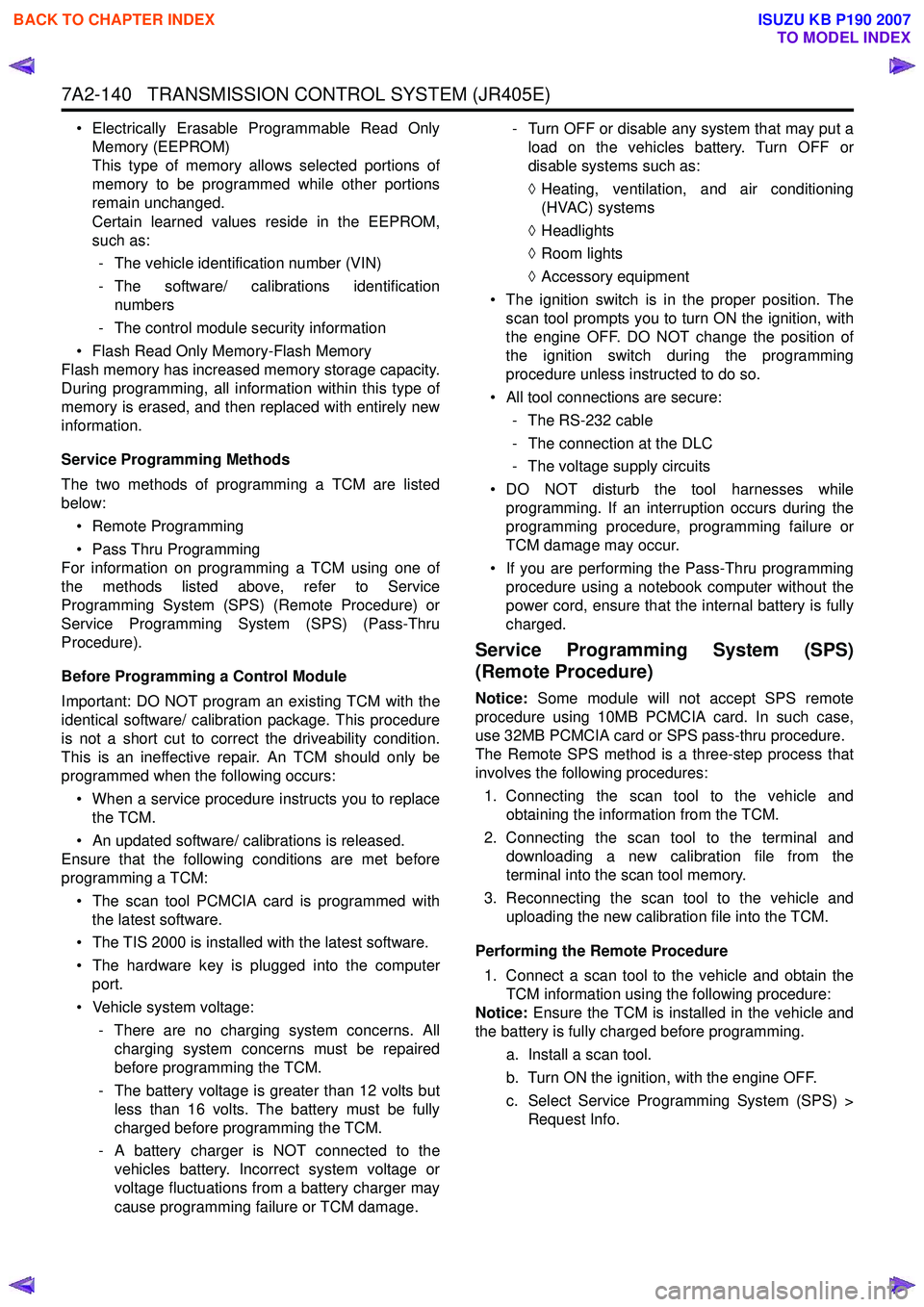
7A2-140 TRANSMISSION CONTROL SYSTEM (JR405E)
• Electrically Erasable Programmable Read OnlyMemory (EEPROM)
This type of memory allows selected portions of
memory to be programmed while other portions
remain unchanged.
Certain learned values reside in the EEPROM,
such as:
- The vehicle identification number (VIN)
- The software/ calibrations identification numbers
- The control module security information
• Flash Read Only Memory-Flash Memory
Flash memory has increased memory storage capacity.
During programming, all information within this type of
memory is erased, and then replaced with entirely new
information.
Service Programming Methods
The two methods of programming a TCM are listed
below:
• Remote Programming
• Pass Thru Programming
For information on programming a TCM using one of
the methods listed above, refer to Service
Programming System (SPS) (Remote Procedure) or
Service Programming System (SPS) (Pass-Thru
Procedure).
Before Programming a Control Module
Important: DO NOT program an existing TCM with the
identical software/ calibration package. This procedure
is not a short cut to correct the driveability condition.
This is an ineffective repair. An TCM should only be
programmed when the following occurs:
• When a service procedure instructs you to replace the TCM.
• An updated software/ calibrations is released.
Ensure that the following conditions are met before
programming a TCM:
• The scan tool PCMCIA card is programmed with the latest software.
• The TIS 2000 is installed with the latest software.
• The hardware key is plugged into the computer port.
• Vehicle system voltage:
- There are no charging system concerns. Allcharging system concerns must be repaired
before programming the TCM.
- The battery voltage is greater than 12 volts but less than 16 volts. The battery must be fully
charged before programming the TCM.
- A battery charger is NOT connected to the vehicles battery. Incorrect system voltage or
voltage fluctuations from a battery charger may
cause programming failure or TCM damage. - Turn OFF or disable any system that may put a
load on the vehicles battery. Turn OFF or
disable systems such as:
◊ Heating, ventilation, and air conditioning
(HVAC) systems
◊ Headlights
◊ Room lights
◊ Accessory equipment
• The ignition switch is in the proper position. The scan tool prompts you to turn ON the ignition, with
the engine OFF. DO NOT change the position of
the ignition switch during the programming
procedure unless instructed to do so.
• All tool connections are secure:
- The RS-232 cable
- The connection at the DLC
- The voltage supply circuits
• DO NOT disturb the tool harnesses while programming. If an interruption occurs during the
programming procedure, programming failure or
TCM damage may occur.
• If you are performing the Pass-Thru programming procedure using a notebook computer without the
power cord, ensure that the internal battery is fully
charged.
Service Programming System (SPS)
(Remote Procedure)
Notice: Some module will not accept SPS remote
procedure using 10MB PCMCIA card. In such case,
use 32MB PCMCIA card or SPS pass-thru procedure.
The Remote SPS method is a three-step process that
involves the following procedures:
1. Connecting the scan tool to the vehicle and obtaining the information from the TCM.
2. Connecting the scan tool to the terminal and downloading a new calibration file from the
terminal into the scan tool memory.
3. Reconnecting the scan tool to the vehicle and uploading the new calibration file into the TCM.
Performing the Remote Procedure 1. Connect a scan tool to the vehicle and obtain the TCM information using the following procedure:
Notice: Ensure the TCM is installed in the vehicle and
the battery is fully charged before programming.
a. Install a scan tool.
b. Turn ON the ignition, with the engine OFF.
c. Select Service Programming System (SPS) > Request Info.
BACK TO CHAPTER INDEX
TO MODEL INDEX
ISUZU KB P190 2007
Page 4970 of 6020
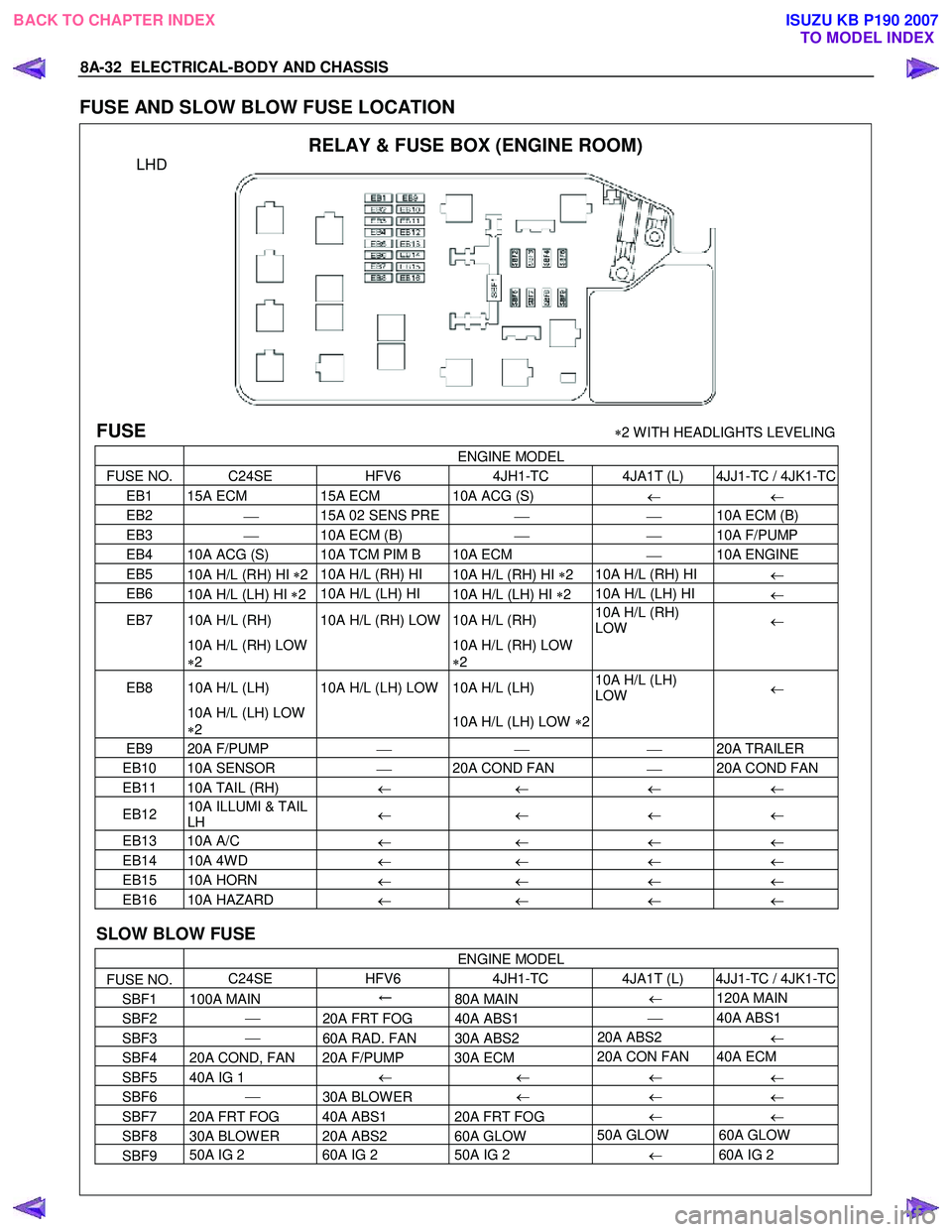
8A-32 ELECTRICAL-BODY AND CHASSIS
FUSE AND SLOW BLOW FUSE LOCATION
RELAY & FUSE BOX (ENGINE ROOM)
LHD
FUSE ∗2 W ITH HEADLIGHTS LEVELING
ENGINE MODEL
FUSE NO. C24SE HFV6 4JH1-TC 4JA1T (L) 4JJ1-TC / 4JK1-TC
EB1 15A ECM 15A ECM 10A ACG (S)
← ←
EB2
15A 02 SENS PRE
10A ECM (B)
EB3
10A ECM (B)
10A F/PUMP
EB4 10A ACG (S) 10A TCM PIM B 10A ECM
10A ENGINE
EB5
10A H/L (RH) HI ∗2 10A H/L (RH) HI
10A H/L (RH) HI ∗2 10A H/L (RH) HI
←
EB6
10A H/L (LH) HI ∗2 10A H/L (LH) HI
10A H/L (LH) HI ∗2 10A H/L (LH) HI
←
EB7 10A H/L (RH) 10A H/L (RH) LOW 10A H/L (RH) 10A H/L (RH)
LOW ←
10A H/L (RH) LOW
∗ 2
10A H/L (RH) LOW
∗ 2
EB8 10A H/L (LH) 10A H/L (LH) LOW 10A H/L (LH)
10A H/L (LH)
LOW ←
10A H/L (LH) LOW
∗ 2
10A H/L (LH) LOW ∗2
EB9 20A F/PUMP
20A TRAILER
EB10 10A SENSOR
20A COND FAN
20A COND FAN
EB11 10A TAIL (RH)
← ← ← ←
EB12 10A ILLUMI & TAIL
LH ←
← ← ←
EB13 10A A/C
← ← ← ←
EB14 10A 4W D
← ← ← ←
EB15 10A HORN
← ← ← ←
EB16 10A HAZARD
← ← ← ←
SLOW BLOW FUSE
ENGINE MODEL
FUSE NO. C24SE
HFV6 4JH1-TC 4JA1T (L) 4JJ1-TC / 4JK1-TC
SBF1 100A MAIN ←
80A MAIN ←
120A MAIN
SBF2
20A FRT FOG 40A ABS1
40A ABS1
SBF3
60A RAD. FAN 30A ABS2 20A ABS2
←
SBF4 20A COND, FAN 20A F/PUMP 30A ECM 20A CON FAN 40A ECM
SBF5 40A IG 1
←
← ←
←
SBF6
30A BLOW ER ←
←
←
SBF7 20A FRT FOG 40A ABS1 20A FRT FOG ←
←
SBF8 30A BLOW ER 20A ABS2 60A GLOW 50A GLOW 60A GLOW
SBF9 50A IG 2
60A IG 2 50A IG 2
← 60A IG 2
BACK TO CHAPTER INDEX
TO MODEL INDEXISUZU KB P190 2007
Page 5090 of 6020
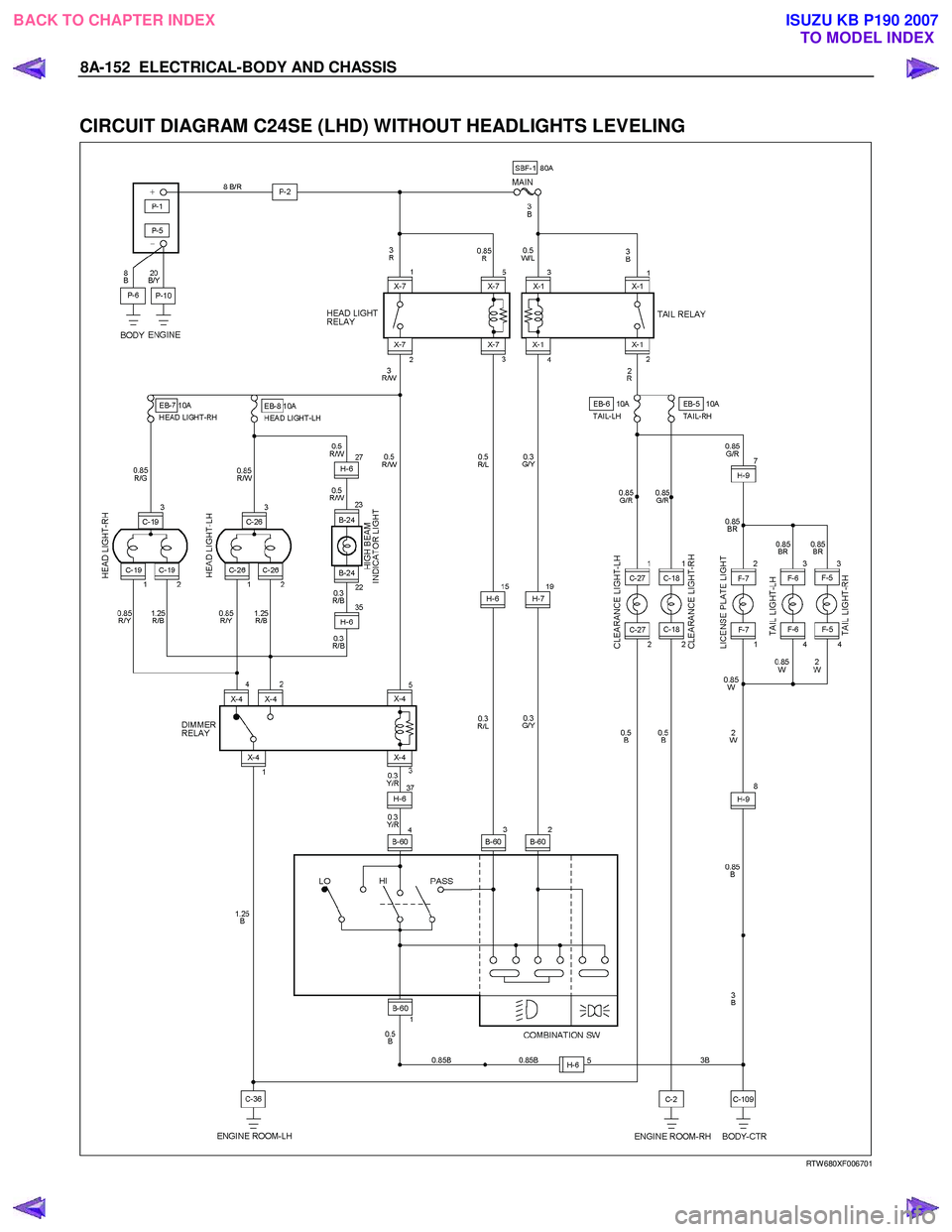
8A-152 ELECTRICAL-BODY AND CHASSIS
CIRCUIT DIAGRAM C24SE (LHD) WITHOUT HEADLIGHTS LEVELING
RTW 680XF006701
BACK TO CHAPTER INDEX
TO MODEL INDEXISUZU KB P190 2007
Page 5091 of 6020
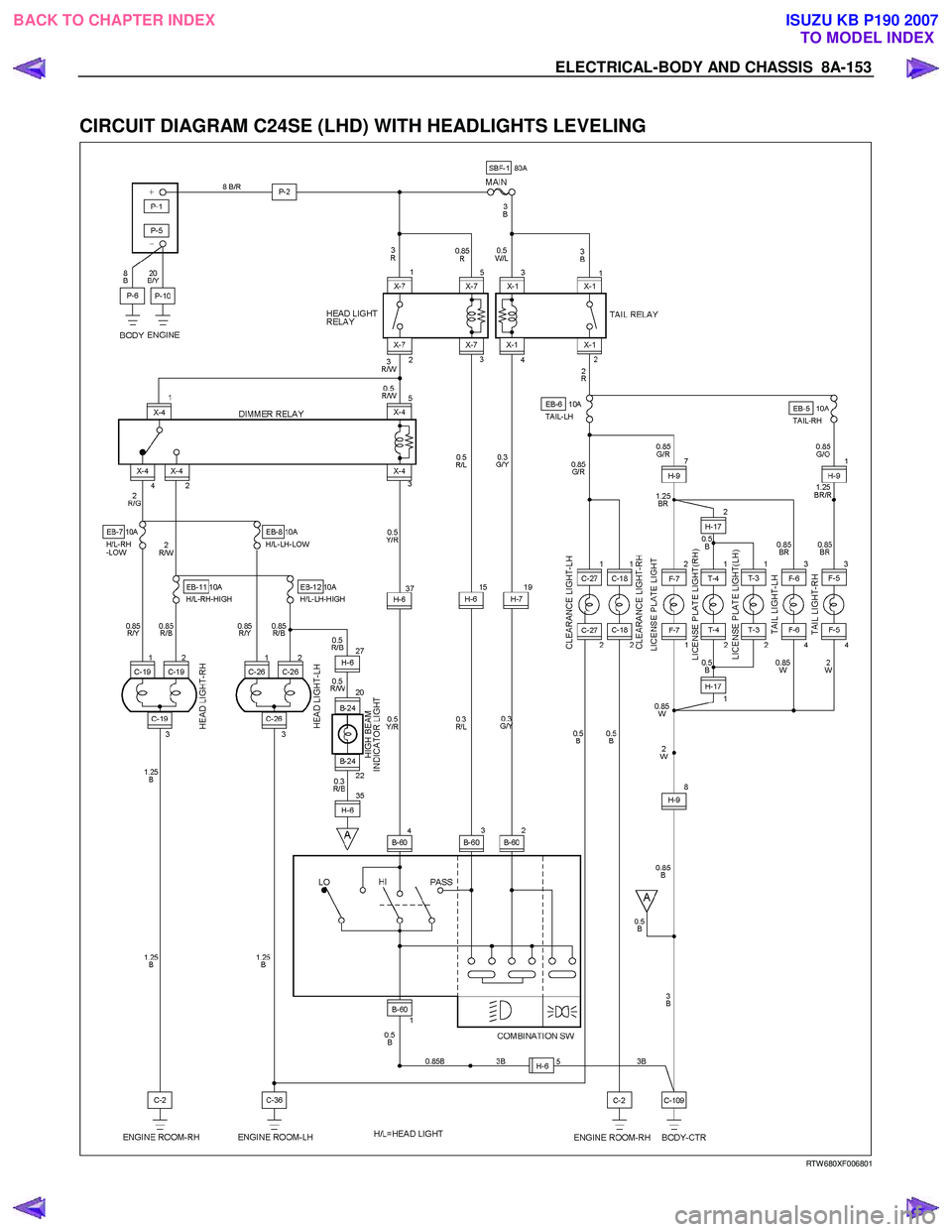
ELECTRICAL-BODY AND CHASSIS 8A-153
CIRCUIT DIAGRAM C24SE (LHD) WITH HEADLIGHTS LEVELING
RTW 680XF006801
BACK TO CHAPTER INDEX
TO MODEL INDEXISUZU KB P190 2007
Page 5098 of 6020
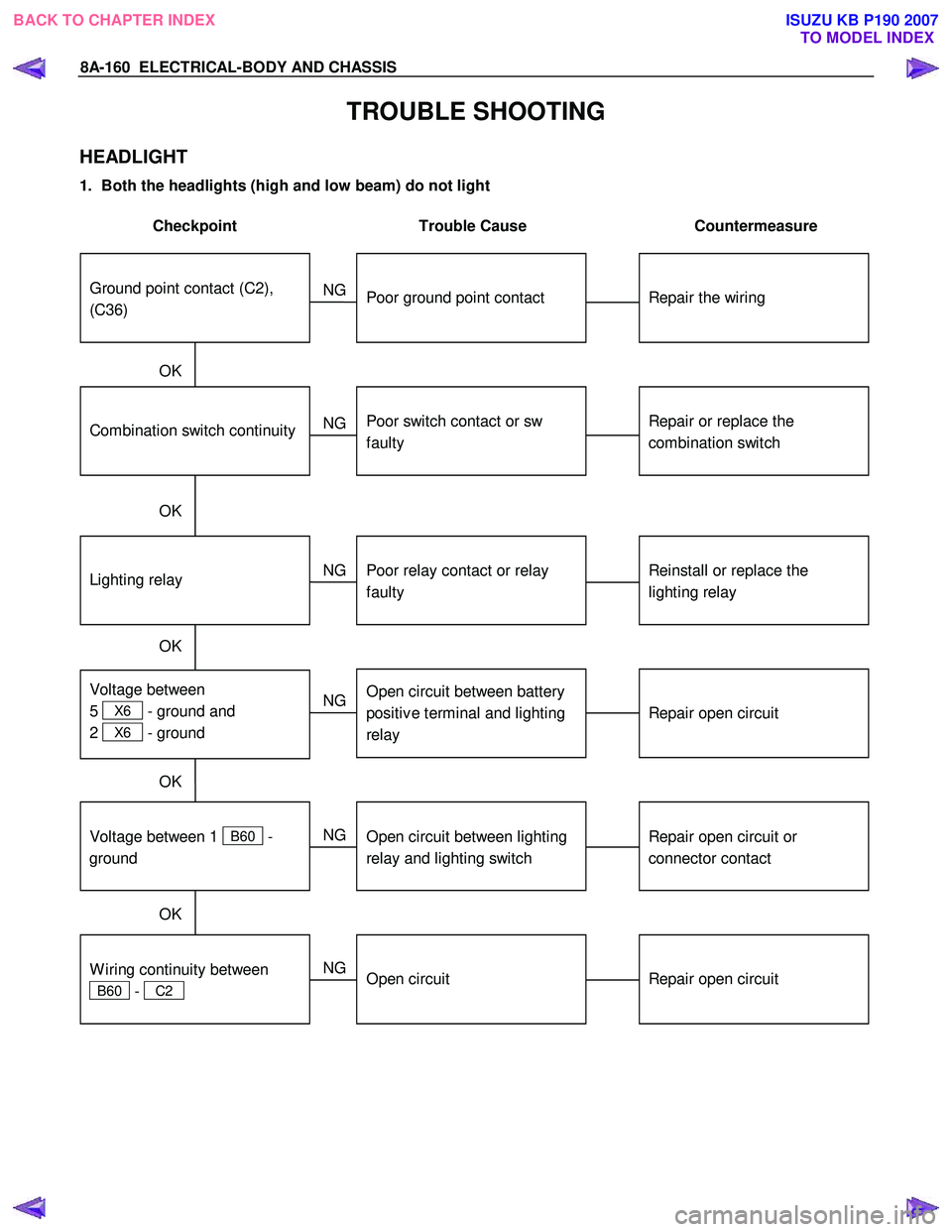
8A-160 ELECTRICAL-BODY AND CHASSIS
TROUBLE SHOOTING
HEADLIGHT
1. Both the headlights (high and low beam) do not light
Checkpoint Trouble Cause Countermeasure
Repair the wiring
Poor ground point contact
NG
Repair open circuit or
connector contact
Repair open circuit
Repair or replace the
combination switch
Voltage between 1
B60 -
ground
Open circuit between lighting
relay and lighting switch
Open circuit between battery
positiv e terminal and lighting
relay
Combination switch continuity
Poor switch contact or sw
faulty
Voltage between
5
X6 - ground and
2
X6 - ground
Reinstall or replace the
lighting relay
Lighting relay
Poor relay contact or relay
faulty
NG
NG
NG
NG
OK
OK
OK
OK
Ground point contact (C2),
(C36)
Repair open circuit
W iring continuity between
B60 - C2
Open circuit
NG
OK
BACK TO CHAPTER INDEX
TO MODEL INDEXISUZU KB P190 2007
Page 5099 of 6020
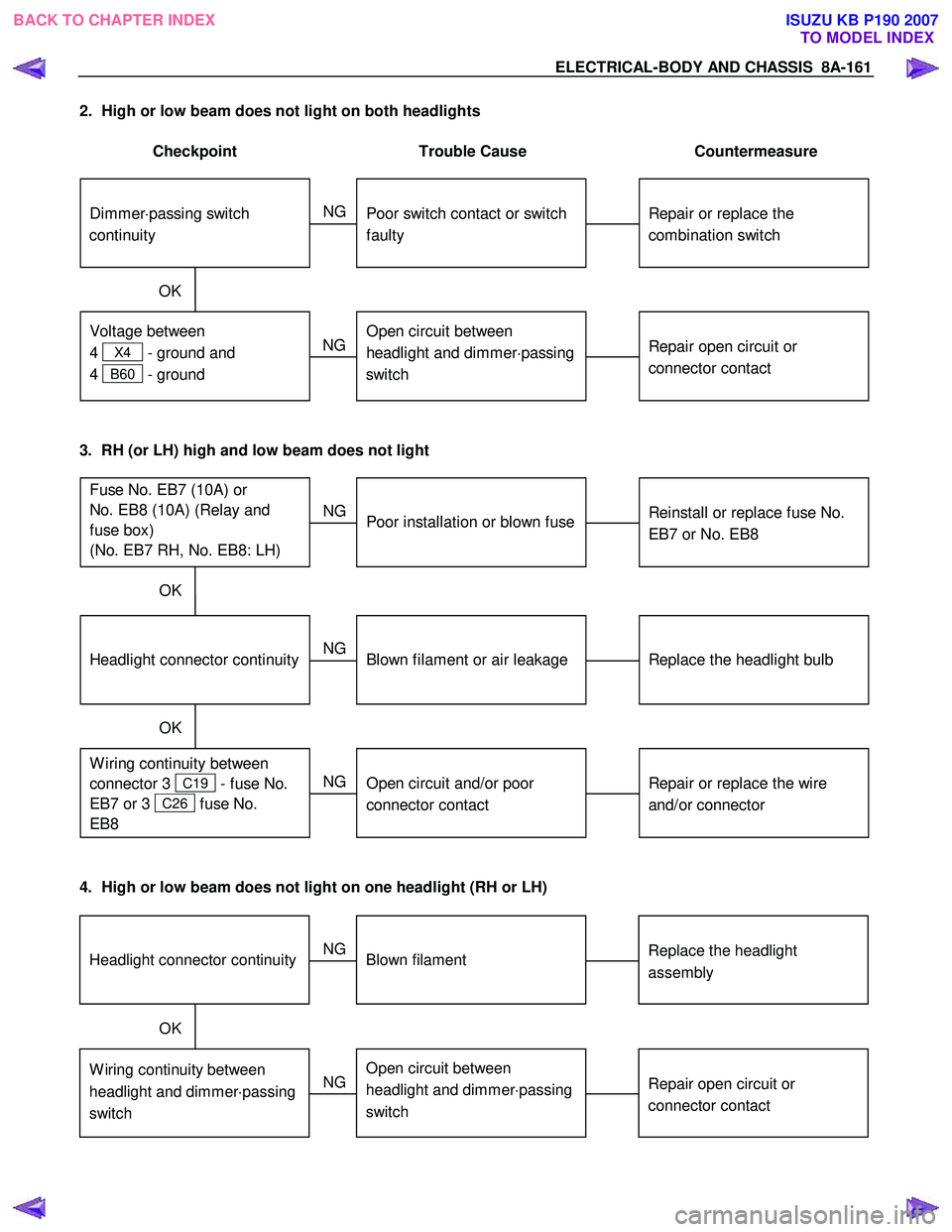
ELECTRICAL-BODY AND CHASSIS 8A-161
2. High or low beam does not light on both headlights
Checkpoint Trouble Cause Countermeasure
Repair or replace the
combination switch
Dimmer ⋅passing switch
continuity
Poor switch contact or switch
faulty
NG
Repair open circuit or
connector contact
Voltage between
4
X4 - ground and
4
B60 - ground
Open circuit between
headlight and dimmer ⋅passing
switch
NG
OK
3. RH (or LH) high and low beam does not light
Replace the headlight bulb
Headlight connector continuity
Blown filament or air leakage
NG
Repair or replace the wire
and/or connector
W iring continuity between
connector 3
C19 - fuse No.
EB7 or 3
C26 fuse No.
EB8
Open circuit and/or poor
connector contact
NG
OK
Reinstall or replace fuse No.
EB7 or No. EB8
Fuse No. EB7 (10A) or
No. EB8 (10A) (Relay and
fuse box)
(No. EB7 RH, No. EB8: LH)
Poor installation or blown fuse
NG
OK
4. High or low beam does not light on one headlight (RH or LH)
Replace the headlight
assemblyHeadlight connector continuityBlown filament
NG
Repair open circuit or
connector contactW iring continuity between
headlight and dimmer ⋅passing
switchOpen circuit between
headlight and dimmer ⋅passing
switch
NG
OK
BACK TO CHAPTER INDEX
TO MODEL INDEXISUZU KB P190 2007
Page 5111 of 6020
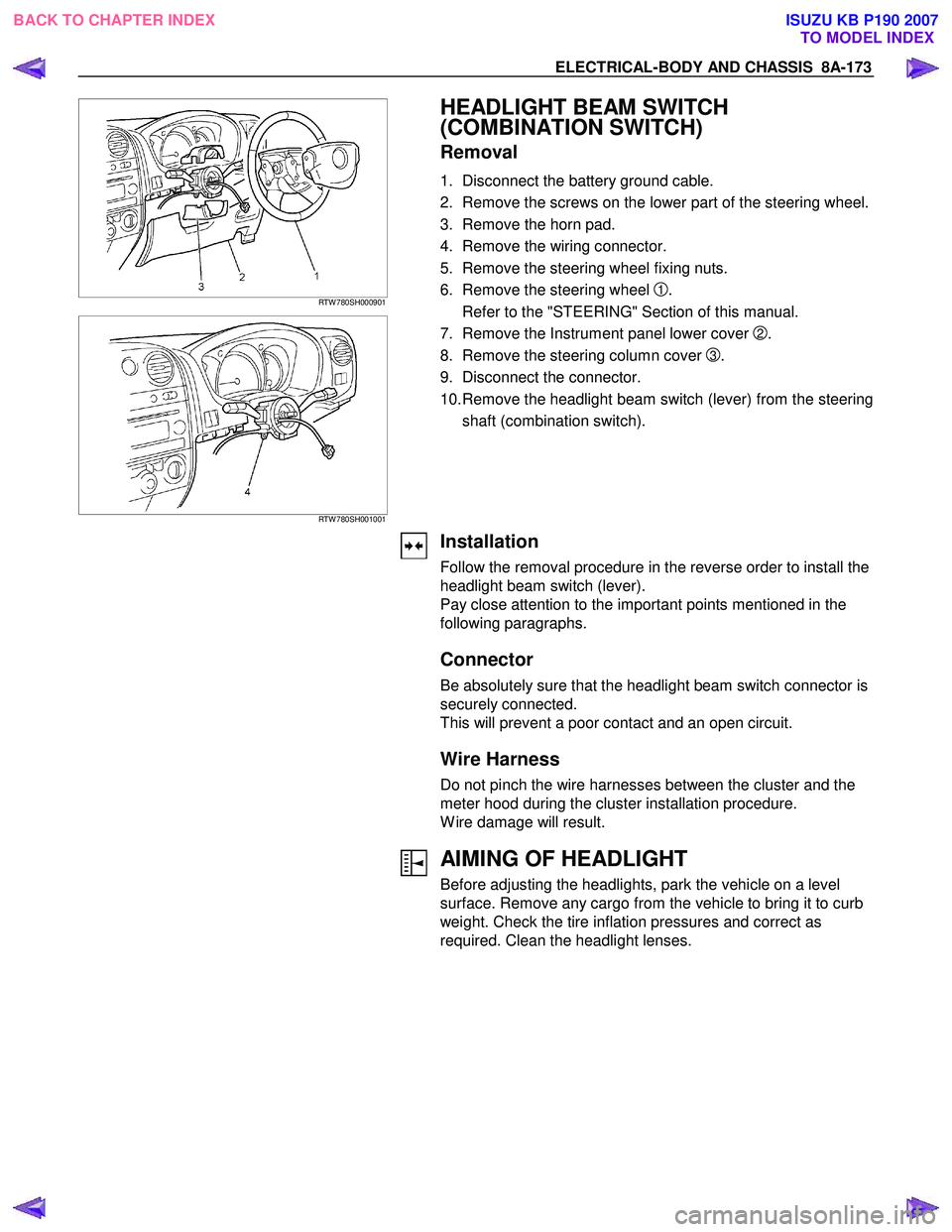
ELECTRICAL-BODY AND CHASSIS 8A-173
RTW 780SH000901
RTW 780SH001001
HEADLIGHT BEAM SWITCH
(COMBINATION SWITCH)
Removal
1. Disconnect the battery ground cable.
2. Remove the screws on the lower part of the steering wheel.
3. Remove the horn pad.
4. Remove the wiring connector.
5. Remove the steering wheel fixing nuts.
6. Remove the steering wheel
1.
Refer to the "STEERING" Section of this manual.
7. Remove the Instrument panel lower cover
2.
8. Remove the steering column cover
3.
9. Disconnect the connector.
10. Remove the headlight beam switch (lever) from the steering shaft (combination switch).
Installation
Follow the removal procedure in the reverse order to install the
headlight beam switch (lever).
Pay close attention to the important points mentioned in the
following paragraphs.
Connector
Be absolutely sure that the headlight beam switch connector is
securely connected.
This will prevent a poor contact and an open circuit.
Wire Harness
Do not pinch the wire harnesses between the cluster and the
meter hood during the cluster installation procedure.
W ire damage will result.
AIMING OF HEADLIGHT
Before adjusting the headlights, park the vehicle on a level
surface. Remove any cargo from the vehicle to bring it to curb
weight. Check the tire inflation pressures and correct as
required. Clean the headlight lenses.
BACK TO CHAPTER INDEX TO MODEL INDEXISUZU KB P190 2007